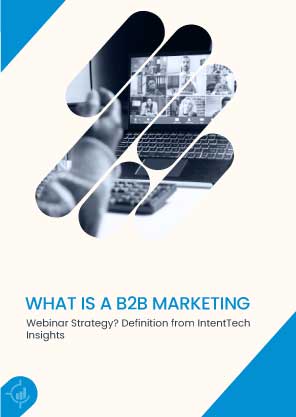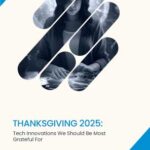or call: +1 (845) 347-8894

or call: +1 (845) 347-8894

We are now in an age where trust is the new currency, and digital fatigue is very real. B2B webinars are breaking through the noise of marketing and have become the cure for the new normal. Webinars do not just share information and educate; they also engage, persuade, and often become the inflection point in a buyer’s decision-making process.
Yet, most organizations still treat and execute webinars as independent campaign tactics versus part of the overall growth strategy. The difference between an average webinar and a strategic webinar is intent, coordination, and follow-up. In this article, we will discuss what makes the winning B2B webinar strategies successful in 2025.
A B2B marketing webinar strategy isn’t just a tactic, but a cohesive process that embeds digital events within your go-to-market motion. At IntentTech Insights™, we define it as a multi-stage system built to educate, qualify, and interest prospects through virtual experiences that reflect the sophistication and individualization of today’s B2B buying process.
Webinars turn strategic when they are supported by data, segmented to particular groups, and quantified for both engagement and revenue impact. That means synchronizing them with your sales workflows, marketing automation software, and CRM so that they become an extension of your sales funnel that is scalable.
Unlike consumer-oriented content strategies, B2B webinar planning needs to be constructed around high-value interactions, not entertainment. Your constituents will demand real insight, peer insight, and industry vision, not glitzy slides.
Webinars encounter B2B buyers where they are: online, aware, and under pressure to find a solution. In a post-pandemic digital-first world, 80% of B2B selling interactions now take place through digital channels. This new reality has made webinars a go-to engagement lever, filling the trust gap between cold outreach and high-intent deal acceleration.
Independent experts—including industry peers, analysts, and vendor executives—are trusted by 66–72% of B2B buyers, highlighting the power of objective, expert-led formats like webinars
Today’s B2B buyers don’t trust salesy copy. They’re seeking insight. They need to learn from their peers, get product differentiators, and assess risk—all in one intuitive flow. Webinars deliver that need through long-form, interactive narratives that establish credibility across decision-making units.
Webinars also provide room for multi-touch marketing. A single event has the capability of driving blogs, short videos, nurture emails, LinkedIn clips, and follow-up training content. This makes a webinar one of the most cost-effective content assets in your demand generation arsenal.
Effective webinars are not isolated events—they’re intent-potivated demand machines powered by structured messaging and ongoing optimization. When done right, a B2B webinar strategy is the foundation of marketing-to-sales alignment, providing clarity at every stage of the funnel.
All successful webinars start with a well-delineated objective. Top-of-funnel awareness, mid-funnel lead qualification, or bottom-of-funnel conversion—whatever the goal, it will inform every other decision, from topic and speaker to CTA and follow-up cadence.
For example, a product-based business may concentrate on demo webinars for conversions, whereas a consulting agency can stress thought leadership sessions for brand trust. SMART goals (Specific, Measurable, Achievable, Relevant, Time-bound) ensure execution is directed and success is quantifiable.
Not every viewer of your webinar is alike, and neither should your message be. Segmenting webinar experiences allows content to match up to the issues and terminology of your audience. A CIO in a financial context will be motivated by varied stimuli than a procurement lead in manufacturing.
Apply firmographic filters such as industry, job function, geo, and tech stack to determine content depth and delivery tone. Segmenting post-webinar follow-up emails by engagement level—e.g., attendees versus registrants—continues the personalization and pipeline conversion improvement.
Advanced marketers also leverage intent data from tools such as Bombora or 6sense to invite accounts that are already exhibiting buying signals, which increases the prospect of attendance and advancement.
Webinars that come across as a veiled sales pitch repel serious buyers. Rather, the best sessions are about practical solutions, peer perspectives, and data-driven narratives. When you provide value first, your viewers are more likely to be open to your solution.
Use authoritative voices—industry analysts, power users, or technical architects—as speakers. Start with a challenge your audience identifies with strongly. Offer benchmarks or frameworks. Finish with tidy, actionable conclusions. If participants leave smarter, they’ll return for more—and they’ll believe in your brand when they’re buying.
Don’t overload with jargon. Even in technical spaces, clarity is king. Utilize visuals, analogies, and actual customer experiences to make points stick.
Webinar success begins long before the session itself—through intelligent, focused promotion. Begin with a compelling registration page that communicates explicitly who the event is for and what benefit they’ll derive. Promote via:
Schedule your promotion calendar at least 2–3 weeks beforehand. Send reminder emails at the 7-day, 1-day, and 1-hour mark. Experiment with subject lines and images to enhance open rates. Internal alignment is essential: engage sales teams early so they can invite prospects and maximize attendance with targeted outreach. The most successful webinars tend to employ warm lead targeting and sales-assisted outreach, not broad blasts.
The webinar isn’t the finish line—it’s the beginning of engaging more deeply. What you do in the 48 hours following a webinar dictates how much pipeline and revenue it drives.
Begin with an instant thank-you email, providing access to the recording and bonus materials such as templates, playbooks, or special PDFs. Segment leads based on engagement and provide highly customized follow-ups: product offers for the person who asked demo questions, additional content for the person who arrived late or left too early.
Coordinate with your sales force to initiate outreach cadences from poll responses or Q&A interactions. Leverage webinar information to enhance lead scores and initiate nurture streams in your marketing automation platform.
Don’t make your webinar a one-and-done. Repurpose it. Break out highlights into a series of blogs, video clips, or carousel posts. These assets are an investment multiplier and reinforce your authority.
Selecting the best format is not merely a matter of taste—it’s about aligning content with where the buyer is in their process. The best B2B marketing organizations use multiple types of webinars, each for particular stages of the funnel.
A full-funnel campaign combines these types across a quarter. For example, a top-of-funnel webinar can be informative, but bottom-funnel ones address buyer objections or competitive benchmarks.
Don’t be shy to experiment with formats. Roundtable and hybrid webinar formats are on the rise in 2025, providing engagement loops for live and post-live experiences.
The technology can either make or break a webinar strategy. Select tools that are integrated into your current martech stack and provide real-time data capture to ensure scalability. The majority of contemporary B2B webinar teams employ a mix of:
Seek out tools such as customizable registration pages, calendar integration, advanced Q&A, and post-event analytics. Most critically, make sure your data streams effortlessly from the webinar platform into your CRM or MAP for prompt follow-up.
Webinar strategies in 2025 are evolving from static broadcasts to hyper-personalized, multi-channel engagement experiences. Marketers must embrace new formats, tools, and data-driven techniques to meet the expectations of digitally mature B2B buyers. These trends redefine how webinars are created, delivered, and measured across the funnel.
Buyers no longer settle for static agendas. AI-driven webinar platforms are tailoring experiences based on job roles, firmographics, and prior behaviors. Attendees now receive personalized content paths, recommended breakout sessions, and context-aware follow-ups that reflect their intent signals, raising both engagement and conversion rates.
Passive listening is out; interactive learning is in. Webinars now feature live polling, emoji reactions, moderated Q&A, clickable CTAs, quizzes, and chat with subject matter experts. This two-way engagement fosters audience ownership, captures buyer signals in real time, and increases average watch times by 30%.
In 2025, time-starved buyers prefer snackable sessions. Micro-webinars—typically 15 to 20 minutes long—focus on single challenges or quick wins. These formats increase completion rates, make on-demand replays more appealing, and allow marketers to build serialized content journeys that mirror how B2B buyers consume information today.
Broad webinar themes are being replaced by hyper-targeted topics tailored to specific personas, verticals, and challenges. A webinar on “Cybersecurity in Healthcare SMBs” will convert far better than a general “Data Security Trends” session. Personal relevance drives registration, attendance, and pipeline influence at every stage of the funnel.
Webinars no longer operate in silos. In 2025, leading marketers link webinars with digital roundtables, live podcasts, virtual product tours, and newsletters. This ecosystem approach ensures consistent messaging, extends the content lifecycle, and offers multiple re-engagement points for prospects who didn’t convert after a single event.
A B2B marketing webinar strategy is not about flooding the screens with slides. It’s about initiating conversations that count, gaining momentum that multiplies, and aligning sales and marketing on shared intelligence. As IntentTech Insights™ looks across high-performing tech campaigns, webinars are no longer a nice-to-have. They’re a foundation of intent-based growth marketing, where value created today propels pipeline tomorrow.
The primary goal is to drive high-intent engagement by offering valuable, real-time experiences that move prospects through the funnel. Unlike standalone webinars, a strategic approach integrates webinars with sales workflows, content repurposing, and lead nurturing for measurable business impact.
B2B webinars prioritize depth, credibility, and education over entertainment. They target multiple decision-makers, focus on complex pain points, and often support long sales cycles. In contrast, B2C webinars lean more on brand storytelling, product demos, and broader emotional appeal.
Live webinars with Q&A, interactive product demos, and niche expert panels are among the top-performing formats. Bite-sized sessions under 30 minutes and AI-personalized content paths are also trending as attention spans shrink and buyer expectations rise.
Key metrics include registration-to-attendance rate, engagement score (polls, Q&A, time spent), influenced pipeline, and follow-up conversion rates. For mature teams, success is also measured by content ROI—how many assets and leads a single webinar generates post-event.
Absolutely. When aligned with sales and powered by intent data, webinars can accelerate buyer journeys, trigger qualified conversations, and drive revenue. Companies that treat webinars as integrated sales tools—not just events—consistently see stronger ROI and shorter deal cycles.
To participate in our interviews, please write to our IntentTech Media Room at sudipto@intentamplify.com




